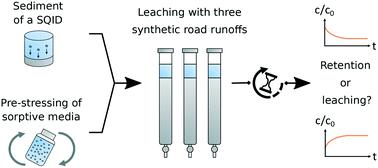当前位置:
X-MOL 学术
›
Environ. Sci.: Water Res. Technol.
›
论文详情
Our official English website, www.x-mol.net, welcomes your
feedback! (Note: you will need to create a separate account there.)
Leaching potential of heavy metals from road-deposited sediment and sorptive media during dry periods in storm water quality improvement devices
Environmental Science: Water Research & Technology ( IF 3.5 ) Pub Date : 2020-05-28 , DOI: 10.1039/d0ew00351d Steffen H. Rommel 1, 2, 3, 4 , Luca Noceti 1, 2, 3, 4 , Philipp Stinshoff 1, 2, 3, 4 , Brigitte Helmreich 1, 2, 3, 4
Environmental Science: Water Research & Technology ( IF 3.5 ) Pub Date : 2020-05-28 , DOI: 10.1039/d0ew00351d Steffen H. Rommel 1, 2, 3, 4 , Luca Noceti 1, 2, 3, 4 , Philipp Stinshoff 1, 2, 3, 4 , Brigitte Helmreich 1, 2, 3, 4
Affiliation

|
Storm water quality improvement devices (SQIDs) mitigate the deteriorating effects of traffic-related contaminants, especially heavy metals. Many SQIDs consist of a settling tank to remove road-deposited sediments in the first treatment stage and dissolved heavy metals are removed by sorptive filtration in the second treatment stage. SQIDs are commonly operated under permanent impounding, resulting in high hydraulic retention times. In this study, we evaluate the leaching potential during dry periods from road-deposited sediment trapped in the settling stage and from three different sorptive media of SQIDs. For this purpose, a new experimental procedure was developed using quiescent batch leaching tests. The sorptive media were pre-stressed with realistic Cu and Zn loads. Three different synthetic road runoffs were used to evaluate the influence of de-icing salts and dissolved organic matter. Strong leaching of heavy metals from road-deposited sediment was observed. In contrast to previous studies on the leaching of Zn from tire wear particles, the process showed limitation by saturation or precipitation after 24 h. Furthermore, no leaching from pre-stressed sorptive media was observed. This highlights that under in situ conditions, leaching from sorptive media is rather unlikely. However, design and operation of SQIDs should consider the leaching potential of road-deposited sediments.
中文翻译:

雨水水质改善装置中道路沉积物和吸附性介质在干燥期的重金属浸出潜能
雨水质量改善设备(SQID)可以减轻交通相关污染物(尤其是重金属)的恶化影响。许多SQID由一个沉淀池组成,以在第一处理阶段清除道路沉积物,并在第二处理阶段通过吸附过滤去除溶解的重金属。SQID通常在永久扣留下运行,从而导致较长的水力停留时间。在这项研究中,我们评估了干燥阶段中沉降阶段捕获的道路沉积物和三种不同SQID吸附介质的浸出潜力。为此,使用静态间歇浸出试验开发了一种新的实验程序。吸附介质预先施加了实际的铜和锌负荷。使用三种不同的合成径流来评估除冰盐和溶解有机物的影响。观察到道路沉积物中重金属的强烈浸出。与先前关于从轮胎磨损颗粒中浸出锌的研究相反,该过程显示出24小时后饱和或沉淀的限制。此外,未观察到预应力吸附介质的浸出。这突显了在原位条件下,从吸附介质中浸出的可能性很小。但是,SQIDs的设计和操作应考虑道路沉积物的浸出潜力。
更新日期:2020-07-02
中文翻译:

雨水水质改善装置中道路沉积物和吸附性介质在干燥期的重金属浸出潜能
雨水质量改善设备(SQID)可以减轻交通相关污染物(尤其是重金属)的恶化影响。许多SQID由一个沉淀池组成,以在第一处理阶段清除道路沉积物,并在第二处理阶段通过吸附过滤去除溶解的重金属。SQID通常在永久扣留下运行,从而导致较长的水力停留时间。在这项研究中,我们评估了干燥阶段中沉降阶段捕获的道路沉积物和三种不同SQID吸附介质的浸出潜力。为此,使用静态间歇浸出试验开发了一种新的实验程序。吸附介质预先施加了实际的铜和锌负荷。使用三种不同的合成径流来评估除冰盐和溶解有机物的影响。观察到道路沉积物中重金属的强烈浸出。与先前关于从轮胎磨损颗粒中浸出锌的研究相反,该过程显示出24小时后饱和或沉淀的限制。此外,未观察到预应力吸附介质的浸出。这突显了在原位条件下,从吸附介质中浸出的可能性很小。但是,SQIDs的设计和操作应考虑道路沉积物的浸出潜力。











































 京公网安备 11010802027423号
京公网安备 11010802027423号